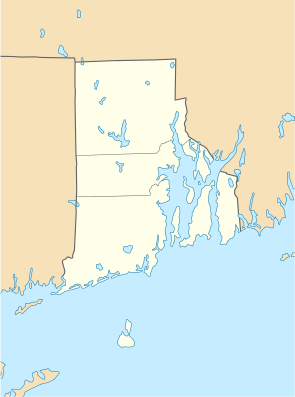Collyer Monument
|
Collyer Monument | |
 | |
|
Collyer Monument | |
 | |
| Location | Pawtucket, Rhode Island |
|---|---|
| Coordinates | 41°52′29″N 71°23′35″W / 41.87472°N 71.39306°WCoordinates: 41°52′29″N 71°23′35″W / 41.87472°N 71.39306°W |
| Built | 1890 |
| Architect | Dowler,Charles |
| Governing body | Local |
| MPS | Pawtucket MRA |
| NRHP Reference # | 83003808[1] |
| Added to NRHP | November 18, 1983 |
Collyer Monument is an historic monument to firefighters in Mineral Spring Park, at the corner of Mineral Spring Avenue and Main Street, in Pawtucket, Rhode Island, USA. The monument was built in 1890 by the sculptor Charles Dowler to honor Samuel Smith Collyer, a fallen Pawtucket firefighter. The life-size bronze sculpture stands atop a pedestal of Westerly granite which contains a bronze plaque showing the fatal accident and the reverse bears the inscription. The Collyer Monument represents a significant example of monumental work of the period and an early example of local civic pride. The monument was added to the National Register of Historic Places in 1983.
Samuel Collyer
Samuel Smith Collyer was born on May 3, 1832 in Pawtucket, Rhode Island.[2][3] After his schooling, he took a job at the Pawtucket Post Office as a clerk and later a was store clerk in a shop. He became a machinist and worked for a period of about seven years before becoming a partner in his uncle, Nathan S. Collyer. When Nathan Collyer died in 1877, the business passed to his wife and then to Samuel Collyer upon her death in 1879. Collyer would maintain control of the business until his death and he would serve on the board of water commissioners in charge of the development of the Pawtucket Water Works. He also played an active role in local administration as a member of the Town Council of North Providence, serving as its president for a period of three years. From 1848 to his death, Collyer was connected to the fire departments of North Providence and Pawtucket, rising to the rank of Chief Engineer in 1874.[2] In 1851, he married Ellen Whipple and they would later have one daughter, Mary Collyer.[4]
The accident that would take the life of Samuel Collyer came in July 1884. While responding to the fire alarm, hose carriage number one struck an upright stone post on the corner on Mineral Spring and Lonsdale Avenue and tipped over. All six firefighters were injured in the accident, those less seriously were on the step and seat of the carriage, but Collyer who rode on the reel was crushed underneath.[4] Collyer sustained a punctured lung and broken ribs, but managed to survive for almost three weeks before succumbing to his injuries.[3][4] Contemporary accounts state that the funeral service and procession were the most elaborate of any in the town's history.[4] Collyer's home, known as the Potter-Collyer House, was listed on the National Register of Historic Places in 1983.[3]
Design

The Collyer Monument was erected in 1890 by the citizen's of Pawtucket for the cost of $2500. Noted sculptor Charles Dowler was commissioned to produce a life-size bronze of Collyer.[4] Dowler sculpture measures 7 feet (2.1 m) high and 4.5 feet (1.4 m) wide and depicts Collyer in full firefighter's uniform with a trumpet in hand.[3] The base is 4.5 feet (1.4 m) wide and 8 feet (2.4 m) tall and made of Westerly granite from Westerly, Rhode Island.[4] A bronze plaque depicts the scene of the accident which claimed his life and his name is inscribed in an arch on the upper portion of the statue's base. The metal picket fence which encloses the statue was designed as part of the monument.[3] On the reverse, the granite base contains the inscription commemorating Collyer who died in the line of duty.[3]
Inscription
Of
Samuel S. Collyer
Who Died July 27, 1884
While In The Discharge
Of His Duty As
Chief Engineer Of The
Pawtucket
Fire Department
Born May 3, 1832.[3]
Significance
The Collyer Monument is historically significant as an example of "the representational, statically monumental approach favored by most American sculptors in the last quarter of the nineteenth century."[3] The monument is also one of the first-known civic sculptures in Pawtucket and serves as a representation of civic pride and artistry in memorializing a local who was held in utmost respect by its citizens.[3] The dedication of this monument came on the concluding day of Pawtucket's Cotton Centenary Celebration in 1890 and was attended by Governor John W. Davis.[4] The Collyer Monument was added to the National Register of Historic Places in 1983.[3]
See also
- National Register of Historic Places listings in Pawtucket, Rhode Island
- List of Registered Historic Places in Rhode Island
References
- ↑ "National Register Information System". National Register of Historic Places. National Park Service. 2007-01-23.
- ↑ 2.0 2.1 R. H. Howard and Henry E. Crocker (1881). A History of New England: Containing Historical and Descriptive Sketches of the Counties, Cities and Principal Towns of the Six New England States, Including, in Its List of Contributors, More Than Sixty Literary Men and Women, Representing Every County in New England, Volume 2 (Google eBook). Crocker & Company. p. 11. Retrieved 14 November 2014.
- ↑ 3.0 3.1 3.2 3.3 3.4 3.5 3.6 3.7 3.8 3.9 "National Register of Historic Places multiple property submission - Pawtucket, Rhode Island". National Park Service. 1983. pp. 74–76. Retrieved November 13, 2014.
- ↑ 4.0 4.1 4.2 4.3 4.4 4.5 4.6 Laxton, Glenn (2009). Hidden History of Rhode Island: Not to Be Forgotten Tales of the Ocean State. The History Press. Retrieved 14 November 2014.
| ||||||||||||||||||||||||||